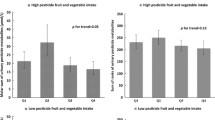Abstract.
The objective of the study was to corroborate or refute the hypothesis that farmers having a high intake of organic grown commodities have a high semen quality due to their expected lower level of dietary pesticides intake. Food frequency data and semen were collected from 256 farmers (171 traditional farmers and 85 organic farmers, overall participation rate: 32%) who were selected from central registers. Each farmer delivered one semen sample before the spraying season started. The farmers were divided into three groups where the commodities from organic production contributed no (N, 0%), medium (M, 1–49%), or a high (H, 50–100%) proportion of the fruit and vegetables consumed. Farmers having a high relative intake of organically grown fruit and vegetables also had a high relative consumption of organically produced meat, milk, and bread, and differences were observed comparing the actual mean intake of single commodities, such as rice, potato, and pork meat. The current individual dietary intake of 40 pesticides was estimated using food frequencies and generalized serving size data in combination with data on pesticide concentrations in food commodities as obtained from the National Danish Food Monitoring Program. The estimated pesticide intake was significantly lower among farmers of group H, but for all three groups of farmers the average dietary intake of 40 pesticides was at or below 1% of the acceptable daily intake (ADI) except for the dithiocarbamates (max = 0.21 μg/kg day = 2.2% ADI), methidathion, (max = 0.01 μg/kg day = 1.4% ADI), and 2-phenylphenol (max = 0.21 μg/kg day = 1.1% ADI). The median sperm concentration for the three groups of farmers was not significantly different (p = 0.40, median sperm concentration was N = 62, M = 44, and H = 75 million/ml). The group of men without organic food intake had a significant lower proportion of morphologically normal spermatozoa, but in relation to 14 other semen parameters no significant differences were found between the groups. Intake of 40 individual pesticides was correlated with four semen parameters (concentration, percentage dead spermatozoa, percentage normal sperm heads, and motility [VCL]). Five significant correlations (p value 0.01) were found among the 160 comparisons in relation to percentage dead spermatozoa: azinphos-methyl, carbaryl, chlorfenson, fenitrothion, and tetradifon. For all of them a lower percentage of dead spermatozoa were found in the groups with a high dietary intake of the specific pesticide. In contrast, for all pesticides evaluated only minor differences were found between the groups when considering spermatozoa concentration, morphology, and motility. In conclusion, the estimated dietary intake of 40 pesticides did not entail a risk of impaired semen quality, but precautions should be taken when generalizing this negative result to populations with a higher dietary exposure level or an intake of other groups of pesticides.
Similar content being viewed by others
Author information
Authors and Affiliations
Additional information
Received: 4 November 1998/Accepted: 7 April 1999
Rights and permissions
About this article
Cite this article
Juhler, R., Larsen, S., Meyer, O. et al. Human Semen Quality in Relation to Dietary Pesticide Exposure and Organic Diet. Arch. Environ. Contam. Toxicol. 37, 415–423 (1999). https://doi.org/10.1007/s002449900533
Issue Date:
DOI: https://doi.org/10.1007/s002449900533




